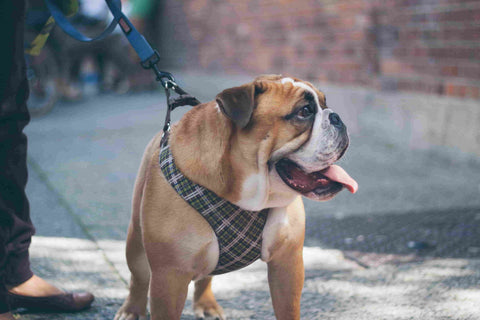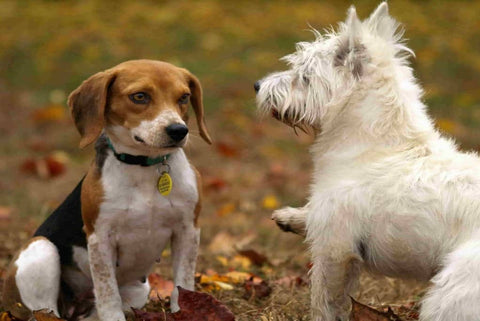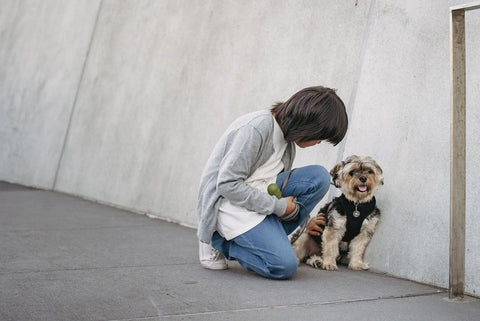What's the Best Harness for a Big Dog?
Walking a big dog can create challenges: you want your dog to be both safe and comfortable, and you should be able to maintain control as well. Luckily, using a dog harness for a big dog is the perfect solution.
When you have a harness, you can control the movement of a big dog and it’s more comfortable for both of you, and you don’t have the worry of injuring your dog. Below we lay out everything you should know to choose the best harness for your big dog.
Which Breeds Fit Large Dog Harnesses?
When we talk about a “big dog,” typically it’s one that’s over 45 pounds and usually with a chest girth of 27 to 32 inches. Even with those estimates, it’s important to measure your dog before buying a new harness. Your dog might be a certain weight, but his chest could be broader or narrower than is typical, for example, making measurements useful. In general, the following breeds might need a large harness:
- Boxer
- Dalmatian
- Golden Retriever
- Labrador Retriever
- Weimaraner
How to Choose the Right Harness
Not all large dog harnesses are the same in terms of comfort, safety, and quality. At Pet&Cuddle we go above and beyond the prioritize all three, and the following are some features to look for and things to think about as you’re choosing a new harness for a big dog.
Select the Type
First, there are a few different types of harnesses that each have their own set of benefits. These include:
- Back-Clip: A back-clip harness is best suited to a dog who’s well-trained and doesn’t tend to lunge or pull. The clip for the leash is on their back or at the top of the harness. It’s comfortable for the dog and easy to use.
- Front-Clip: If your dog does pull or is still training on how to walk properly on a leash, then you might want a front-clip harness. A front-clip harness can put tension between your dog’s shoulders if he tries to pull, so it helps teach not to do this. A front-clip harness also gives you the highest level of control.
- Dual-Clip Dog Harness: We recommend a dual-clip dog harness. A dual-clip harness features a back and front clip. You can use them in different situations, as needed. For example, if you’re training, you can use the front, and then as your dog gets more comfortable and learns not to pull, transition to the back clip.
- Step-In Dog Harness: A step-in harness forms triangles around your dog’s legs when you put it on instead of rectangles. It’s comfortable and also secure and reduces the risk of your dog breaking free.
Measure Your Dog to Get the Right Size
Measuring your dog first ensures that you’re going to get that perfect fit in a harness. Use the steps below and then compare the measurements to our Pet&Cuddle harness size charts:
1) Measure the Neck Girth: Use a tape measure, and go to the point of your dog’s neck that’s the thickest. This is typically where a traditional collar would sit on their neck. Wrap your tape measure around this widest point until it’s touching. You want to be snug in your measurements but not too tight.
2) Belly Girth Measurement: Your dog’s belly girth is measured at the widest point of his body on his underside. You’ll probably measure this point at about an inch in front of his back legs.
3) Body Length: Measure the length of your dog starting behind his front leg and to the point right behind his rear leg.
4) Weight: It can also be helpful to know your dog’s weight when you’re choosing a harness.
If you compare your measurements to the size chart and find that your dog is on the upper limit of one size, go up. If the dog harness has adjustable belts, you can always tighten them a bit if needed, but if it’s too small, there’s not much you can do about that.
To test the fit and size once you get your new harness, first, put two fingers between your dog’s fur and the straps at different points. You should be able to snugly fit two fingers anywhere. Try to pull the harness over your dog’s head as well. If you can, it’s not the right fit. If you’re ever unsure about measuring your dog or getting the best fit, contact us, and we can help.
Achieve a Proper Fit
When you take your dog for a walk in his new harness, watch him along the way. Is he responding well, or does it seem to be irritating him? If so, it could be too tight. A good-fitting harness should never cause discomfort or restrict movement.
Main Features to Look for in a Dog Harness
When comparing dog harnesses, there are a lot of options available. Prioritize the most important features, including:
- Safe Design: A safe design is one that fits well, doesn’t put too much pressure on any one point of your dog’s neck, and doesn’t cause health issues or injuries. All Pet&Cuddle harnesses are designed with the highest safety specifications.
- Easy to use: If your dog harness is easy to use it’s going to encourage you to take more walks, benefiting your dog physically and mentally. Look for a user-friendly design that’s easy to take on and off quickly. As a side note, always take your dog’s harness off when you return from a walk because they aren’t meant to be worn all the time.
- Adjustable belts: Having an adjustable dog harness goes back to the importance of a perfect fit. You can customize the fit of your dog’s harness as needed.
- Weight: Look for a lightweight, ergonomic design that you can quickly add to your bag no matter where you’re headed.
- Clip Location: We prefer a harness with two clips—one at the front and one at the back. This gives you versatility in how you use it and lets you navigate different situations easily.
- Reflective straps: If you walk when it’s dark out, such as in the early morning or evening, reflective details are essential.
- Material: Opt for soft, non-irritating materials that will feel great on your dog’s skin and won’t cause injuries.
Is It Okay to Use a Retractable Leash with a Harness?
One of the main questions we hear is whether or not it’s safe to use a retractable leash with a harness. We think retractable leashes are better than fixed-length options because they give you the ability to walk your dog comfortably in both open areas and more congested spaces. You also have a greater level of control.
A retractable leash can be safely used with a harness too. The main thing to remember is that if you have a retractable leash, use the top clip of your harness. If you’re going to use the front clip, give the leash line some slack. Otherwise, your dog might learn bad behaviors because he’ll think he’s pulling even if he’s not.
Otherwise, yes, a retractable leash and a harness can be used safely together.
Should You Really Use a Harness for Large Dogs?
For sure, we absolutely recommend using a harness for a big dog. Get the right fit and choose a comfortable design, and you’ll find your dog’s walking behaviors improve and there will probably be less pulling. You’ll feel better too because you’ll have more control without putting too much strain on your arms and shoulders.
We, the Pet&Cuddle dog lovers, are constantly creating new dog harness collections, which are safe, multifunctional, and effective for training, leading, or adapting purposes.
Discover the latest dog harness collection we created exactly for your dog here.
Questions About Using Harnesses for Big Dogs
We often get to interact directly with our customers, and we love to be able to provide them with information from our experience. With that in mind, we put together a list of some of the questions we hear most often about using a harness for a big dog.
Are Harnesses More Secure for Large Dogs?
When compared to a collar, a harness is more secure. It’s easy for a dog to slip out of a traditional collar. It’s also more likely that your dog can pull away from you when you’re using a collar because you have less control.
Are Harnesses Safer for Big Dogs?
A harness is a safer option than a collar for big dogs because rather than putting all of the pressure at one point on the neck, they distribute it evenly across the body. This greatly reduces the risk of discomfort and injury.
Are Harnesses More Comfortable for Big Dogs?
The reason a harness is more comfortable for a big dog is similar to why it’s safer. You’re not putting a lot of force and pressure on the neck alone. You get the advantages of being able to control your walks and even train your dog without hurting or choking them.
What Age Can Dogs Start Using a Harness?
We recommend asking your vet what age you should start your dog with a harness, but they tend to work well for most ages. The general rule of thumb is to wait until your puppy is at least eight months before using a harness.
When Should You Use a Harness?
Any time you’re out and about with your dog, you can use your harness. This includes on walks, in parks, or in public places where you need a sense of control. Just remember to take it off when you get home, but otherwise, it will work well across different situations.
Do Harnesses Encourage Pulling?
A harness does not encourage pulling. In fact, it does the opposite and can be an effective training tool. If you use the front clip of a harness, in particular, it puts a bit of tension on a dog’s shoulder blades and helps train them against pulling.
Get The Perfect Large Dog Harness from Pet&Cuddle
Once you choose the right harness for your dog, you’ll get plenty of use out of it. You can explore the world together and do so comfortably and safely.
Our Pet&Cuddle team knows the best harnesses, which perfectly fit your dog! Comfortable and safe, it now can be easily used for preventing your dog from pulling and other activities like training, walking, or adapting to a leash.




